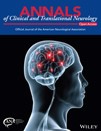Objective: The King–Devick (K-D) test, which is based on rapid number naming speed, is a performance measure that adds vision and eye movement assessments to sideline concussion testing. We performed a laboratory-based study to characterize ocular motor behavior during the K-D test in a patient cohort with chronic concussion to identify features associated with prolonged K-D reading times.
Methods: Twenty-five patients with a concussion history (mean age: 31) were compared to control participants with no concussion history (n = 42, mean age: 32). Participants performed a computerized K-D test under infrared based video-oculography.
Results: Average intersaccadic intervals for task-specific saccades were significantly longer among concussed patients compared to controls (324.4 ± 85.6 msec vs. 286.1 ± 49.7 msec, P = 0.027). Digitized K-D reading times were prolonged in concussed participants versus controls (53.43 ± 14.04 sec vs. 43.80 ± 8.55 sec, P = 0.004) and were highly correlated with intersaccadic intervals. Concussion was also associated with a greater number of saccades during number reading and larger average deviations of saccade endpoint distances from the centers of the to-be-read numbers (1.22 ± 0.29° vs. 0.98 ± 0.27°, P = 0.002). There were no differences in saccade peak velocity, duration, or amplitude.
Interpretation: Prolonged intersaccadic intervals, greater numbers of saccades, and larger deviations of saccade endpoints underlie prolonged KD reading times in chronic concussion. The KD test relies upon a diffuse neurocognitive network that mediates the fine control of efferent visual function. One sequela of chronic concussion may be disruption of this system, which may produce deficits in spatial target selection and planning of eye movements.
Summary Points:
- Laboratory-based eye movement study completed to determine eye movement performance in a concussion cohort to identify features leading to K-D reading time prolongation in concussion.
- Inter-saccadic intervals (ISI) time represents a combined measure of saccade latency and fixation duration.
- ISI was greater in concussed subjects vs. non-concussed controls.
- Digitized K-D reading times were prolonged in concussed vs. non-concussed controls.
- There were no differences in saccade velocity, acceleration or deceleration between groups.
- ISI and number of saccades (small amplitude, <20deg) correlated with K-D time.
- ISI and number of saccades (small amplitude, <20deg) also correlated with change in Post Concussion Symptom Inventory (PCSI) score.
- Efficient K-D test performance requires eye movements that are not only rapid and accurate, but also requires the integration of information obtained continuously from each fixation to read, verbalize, plan the motor movement, and direct attention to the next number.

